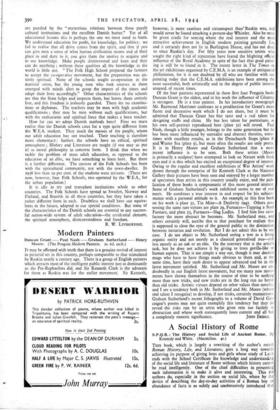Modern Painters
IT may be affirmed with truth that there is a genuine revival of interest in pictorial art in this country, perhaps comparable to that stimulated by Ruskin nearly a century ago. There is a group of English painters which attracts most of the intelligent public interest just as dominantly as the Pre-Raphaelites did, and Sir Kenneth Clark is the advocate- for them as Ruskin was for the earlier movement. Sir Kenneth, however, is more cautious and circumspect than•Ruskin was, and would never be found attacking a present-day Whistler. Also he must be given credit for sensing where the real interest and the most attractive achievement in English modern painting generally lies, and it certainly does not lie in Burlington House, and has not done so since Ruskin's day. For fifty years now sensitive artists who sought the right kind of reputation have feared the blighting official influence of the Royal Academy in spite of the fact that good paint- ing is still be to found in it. The recent letter in The Times on the art exhibitions organised by C.E.MA. is an example of antiquated philistinism, for it is not doubted by all who are familiar with our painting today that the C.E.M.A. exhibitions have been among the most successful, both artistically and in the degree of public interest aroused, of recent times.
Of the four painters represented in these first four Penguin books Duncan Grant is the oldest, and in his work the influence of Ceramic is strongest. He is a true painter. In his introductory monograph Mr. Raymond Mortimer confesses to a predilection for Grant's more fluent and decorative work which I do not share, but it must be admitted that Duncan Grant has fine taste and a real talent for designing stuffs and china. He has less talent for portraiture, as his own self-portrait reproduced here (plate 32) will reveal. Paul Nash, though a little younger, belongs to the same generation but he has been more influenced by surrealist and abstract theories, some- times with excellent results, as in the Dymchurch Steps (plate 8) and.Winter Sea (plate 9), but more often the results are only pretty. It is in Henry Moore and Graham Sutherland that a more recent influence is to be seen. Both these artists .(Moore is primarily a sculptor) have attempted to look on Nature with fresh eyes and it is this which has excited an exceptional degree of interest. Owing to the regular and excellent exhibitions of War Artists' work shown through the enterprise of Sir Kenneth Clark at the National Gallery their pictures have been seen and enjoyed by a larger .number of spectators than artists in this country usually enjoy, and the pub- lication of these books is symptomatic of this more general interest. Some of Graham Sutherland's work exhibited seems to me of real merit. He combines a true interest in and respect for his subject- matter with a personal attitude to it. An example, in this first book on his work is plate 31, Tin Mine—A Declivity 1942. Others pos- sessing the same rare virtues are plate 29, Furnaces—Tapping a Steel Furnace, and plate 23, Furnaces—Slag Ladles. I find him less satis- factory ihe more abstract he becomes. Mr. Sutherland may, and others certainly will, ascribe this to that penchant for realism that is supposed to close the eyes of the general public to the distinction between imitation and revelation. But I do not admit this to be my case. I do not object to Mr. Sutherland seeing a tree _as a living organic entity and not merely as a classical generalised tree—still less merely as an oak or an elm. On the contrary that is the artist's task, but he does not achieve it by giving to trees gorilla-like or human aspects. That is too simple a way out, though it may deceive mugs who have to have things made obvious to them and, at the same time, have their snob desire to appear advanced and be in the latest movement satisfied. Mr. Sutherland and Mr. Moore are un- doubtedly in our English latest movement, but too many new move- ments have shown themselves in the course of time to be nothing more than new tricks, and new tricks are in the long run no better than old tricks. Artistic virtues depend on other values than novelty, and I see a tendency both in Mr. Sutherland and Mr. Moore (whose real talent I recognise) to develop, if not tricks, certainly mannerisms. Graham Sutherland's recent lithographs to a volume of David Gas- coigne's poems may not quite exemplify this tendency but they do reveal the risks run by an artist who gives rein too facilely to abstraction and whose work consequently loses content and all but a completely esoteric significance. JOHN BUDGE.


























 Previous page
Previous page